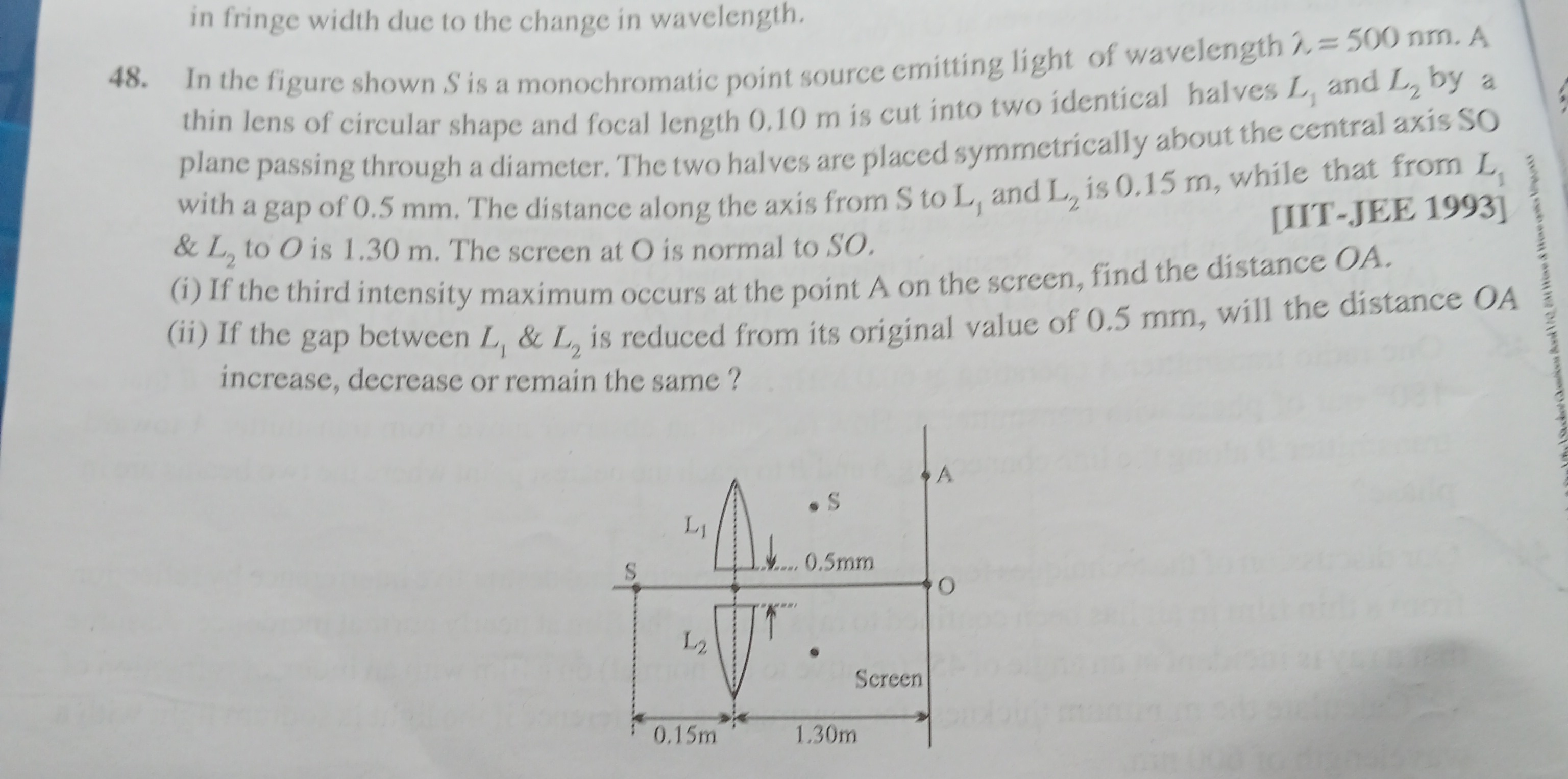Question
Question: In the figure shown S is a monochromatic point source emitting light of wavelength $\lambda = 500$ n...
In the figure shown S is a monochromatic point source emitting light of wavelength λ=500 nm. A thin lens of circular shape and focal length 0.10 m is cut into two identical halves L1 and L2 by a plane passing through a diameter. The two halves are placed symmetrically about the central axis SO with a gap of 0.5 mm. The distance along the axis from S to L1 and L2 is 0.15 m, while that from L1 & L2 to O is 1.30 m. The screen at O is normal to SO. [IIT-JEE 1993]
(i) If the third intensity maximum occurs at the point A on the screen, find the distance OA.
(ii) If the gap between L1 & L2 is reduced from its original value of 0.5 mm, will the distance OA increase, decrease or remain the same?

1 mm, increase
Solution
The problem describes an optical setup where a point source S is placed on the axis of a lens, which is cut into two halves L1 and L2 separated by a gap. This arrangement creates two coherent sources, which are the images of S formed by the two lens halves. The resulting interference pattern is observed on a screen.
(i) First, we find the position of the images of the source S formed by the lens halves. The source is at a distance u=−0.15 m from the lens. The focal length of the lens is f=0.10 m. Using the lens formula v1−u1=f1: v1=f1+u1=0.101+−0.151=110−15100=10−320=330−20=310. So, the image distance is v=0.30 m. The images S1 and S2 are formed at a distance of 0.30 m from the lens plane.
The two lens halves are separated by a gap of 0.5 mm and placed symmetrically about the central axis SO. This means that the optical axis of L1 is shifted upwards and the optical axis of L2 is shifted downwards from the original axis. Let the vertical shift of the optical axis of L1 be y0 upwards and L2 be y0 downwards. The gap between the inner edges is 0.5 mm. Assuming the original lens was centered on the axis and had a diameter much larger than the gap, the optical centers of the two halves are separated by the gap plus some part of the lens. However, the problem states "with a gap of 0.5 mm". This gap is between the two halves. Let's assume the optical center of L1 is at a height y0 above the axis and the optical center of L2 is at a depth y0 below the axis, such that the separation between the optical centers is 2y0. The gap of 0.5 mm is the distance between the closest edges. Let's consider the effect of shifting the lens. If the lens is shifted transversely by y0, the image is shifted by y′=(1−uv)y0. Here u=−0.15 m and v=0.30 m, so uv=−2. The shift in the image is y′=(1−(−2))y0=3y0. The problem statement and figure suggest that the gap of 0.5 mm is the separation between the two halves. A common interpretation for such a setup is that the two lens halves are obtained by cutting the lens along a diameter and then separating the two halves by a distance d=0.5 mm. In this case, the two coherent sources are formed at a distance v from the lens plane, and their separation is d′=(1−uv)d. d′=(1−(−2))×0.5 mm=3×0.5 mm=1.5 mm.
So, we have two coherent sources S1 and S2 separated by a distance d′=1.5 mm =1.5×10−3 m. These sources are located at a distance of 0.30 m from the lens plane. The screen is at a distance of 1.30 m from the lens plane. The distance from the coherent sources to the screen is D=1.30−0.30=1.00 m. The wavelength of light is λ=500 nm =500×10−9 m.
This setup is equivalent to a double-slit experiment with slit separation d′, screen distance D, and wavelength λ. The central maximum is at point O on the screen. The position of the n-th intensity maximum from the central maximum is given by yn=d′nλD. We are looking for the distance OA, which is the position of the third intensity maximum, so n=3. OA=y3=d′3λD=1.5×10−3 m3×(500×10−9 m)×1.00 m. OA=1.5×10−31500×10−9 m=1.51500×10−6 m=1000×10−6 m=1×10−3 m=1 mm.
(ii) If the gap between L1 and L2 is reduced from its original value of 0.5 mm, the separation between the two coherent sources d′ will also be reduced. From the formula d′=3d, if d decreases, then d′ decreases. The distance OA is given by OA=d′3λD. Since OA is inversely proportional to d′, if d′ decreases (due to the reduction in the gap), the distance OA will increase.
The final answer is 1 mm, increase.
Explanation of the solution: (i) The two lens halves form two coherent images of the source S. The distance of the images from the lens is v=0.30 m. The separation between the images is d′=3d, where d=0.5 mm is the gap between the lens halves. So, d′=3×0.5=1.5 mm. The distance from the images to the screen is D=1.30−0.30=1.00 m. The distance of the third maximum from the center is y3=d′3λD=1.5×10−33×500×10−9×1.00=1×10−3 m =1 mm. (ii) The distance OA is inversely proportional to the separation of the coherent sources d′. The separation d′ is proportional to the gap between the lens halves. If the gap is reduced, d′ decreases, and thus OA increases.
